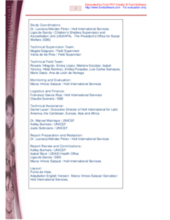The report documents the baseline study of institutions that provide care and shelter to institutionalized children and adolescents in Guatemala and helped determine the state of children and adolescents that live in those institutions. The following specific objectives were developed in order to achieve the general objective:
- To identify the number of institutions that provide care to institutionalized children and adolescents, the locations of these homes as well as their technical capacity, infrastructure and access to care resources.
- To determine the main reasons children and adolescents are in shelters, how long they stay as well as geographic and regional factors that have an affect on childcare.
The main findings of the study were the following:
- 95% of the shelters are private and 5% are public, which demonstrates that the private sector is responsible for the vast majority of institutionalized children.
- Of the total number of institutionalized children and adolescents (5,600) at the shelters, 33% have been declared permanent shelter residents.
- 33% of the total numbers of children and adolescents residing at the shelters (1,846) have been declared permanent residents, in violation of their right to have a family. Although 8% (443) have been declared adoptable, they continue to reside in the shelters, demonstrating that institutions are not putting forward enough effort into ensuring that each youth finds a family.
- According to internal shelter records, the legal status of 58% of the total number of institutionalized children and adolescents (3,227) is pending. This is inconsistent with the PINA law that states that shelters should be temporary homes and not permanent homes.
- There are children and adolescents that still don’t have birth certificates, which is a violation of their right to an identity.
- The majority of private shelters are unaware of minimum, internationally recognized standards for shelter operations.
The comprehensive recommendation plan included the following:
- Develop and agree upon an agenda for Guatemalan children and adolescents including strategies related to national and international legal frameworks regarding the best interests of minors.
- Include issues related to institutionalized minors in country and public policy priorities, especially those of the SBS and the National Adoption Council, in order to define strategies that protect the right to a family and the restoration of violated rights.
- Raise the awareness of decision makers in order to increase the national budget allotted for issues affecting children and adolescents, especially those that are not in the care of their parents.
- Define intersectoral mechanisms that promote and facilitate the deinstitutionalization of the country
- Raise the awareness of and promote the adoption of minimum standards for both public and private children’s shelters. This implies strengthening the role of USAHPA in regards to the development, monitoring and evaluation of standards for all children’s shelters operating in the country.

